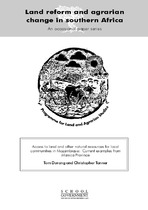| dc.contributor.author | Durang, Tom | |
| dc.contributor.author | Tanner, Christopher | |
| dc.date.accessioned | 2019-03-07T10:04:26Z | |
| dc.date.available | 2019-03-07T10:04:26Z | |
| dc.date.issued | 2004 | |
| dc.identifier.citation | Durang, T. & Tanner, C., 2004. Access to land and other natural resources for local communities in Mozambique: Current examples from Manica Province. Cape Town: Institute for Poverty Land and Agrarian Studies (PLAAS). | en_US |
| dc.identifier.isbn | 1-86808-615-1 | |
| dc.identifier.uri | http://hdl.handle.net/10566/4385 | |
| dc.description.abstract | Mozambique is still one of the poorest countries in the world. Given that poverty remains overwhelmingly rural in nature, measures to effectively address it should therefore be targeted to the areas where the rural poor live, and should be based on the resources within their control.
A programme to achieve these objectives began after the end of the civil war in 1992. This coincided with the government of Mozambique embarking on a more market-oriented rural development model after a period of socialised agriculture. The government realised that, despite being marginalised, rural
communities continue to play a crucial role in the development and land management process. Old beliefs that local communities only produce for subsistence and do not invest and respond to market dynamics proved to be inaccurate. | en_US |
| dc.language.iso | en | en_US |
| dc.publisher | Institute for Poverty Land and Agrarian Studies (PLAAS) | en_US |
| dc.relation.ispartofseries | Land reform and agrarian change in Southern Africa;27 | |
| dc.subject | Mozambique | en_US |
| dc.subject | Natural resources | en_US |
| dc.subject | Local communities | en_US |
| dc.subject | Manica Province | en_US |
| dc.subject | Poverty alleviation | en_US |
| dc.subject | Sustainable natural resource | en_US |
| dc.title | Access to land and other natural resources for local communities in Mozambique: Current examples from Manica Province | en_US |
| dc.type | Book | en_US |

